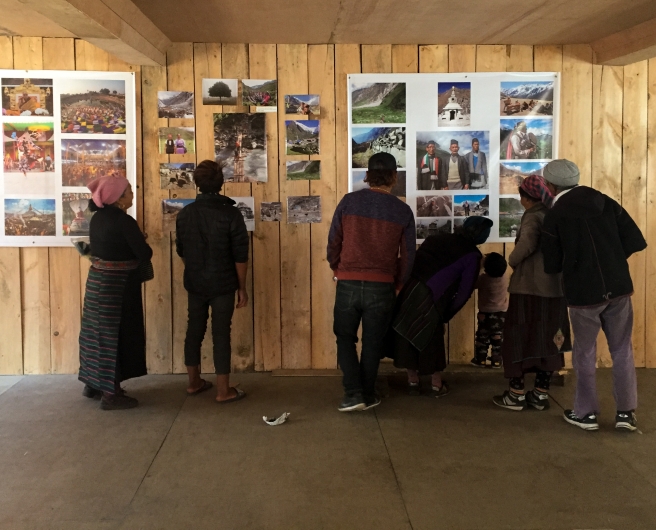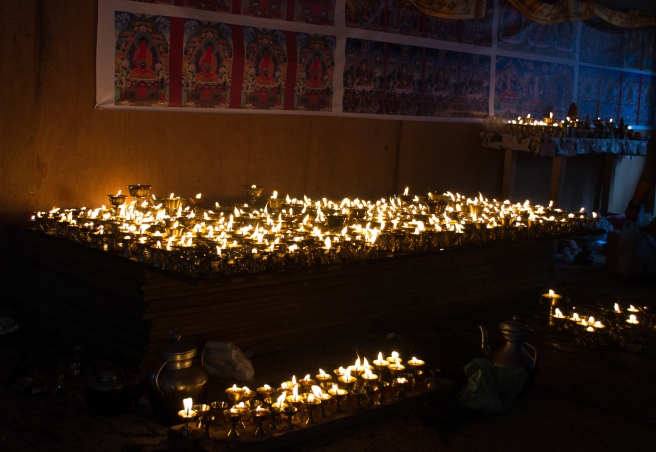Dear Readers,
I have returned from the Langtang Valley! I was there for 15 days, during which time I conducted some vital fieldwork for the ‘Langtang Memory Project’, reconnected with the local community, and learned quite a lot. There is much to say and many stories that I hope to share with you over the coming weeks.
I installed the ‘Langtang Means Home’ photo exhibition in commemoration of the two-year anniversary of the earthquake that devastated the Langtangpa community during my time there. The exhibition displayed the work of Langtangpa photographers, giving the community a chance to reflect on the past and collectively view their work in the place that they call home.

The anniversary of the earthquake is on April 25 on the ‘Gregorian calendar’, but the ‘Tibetan Calendar’ functions differently. This year on the Tibetan Calendar, used by the Langtangpas for religious purposes, the anniversary fell on May 2. On this day the community held a Puja to honor those who were lost to the earthquake. Langtangpas from all over the Langtang Valley came to attend this day-long Puja—a tradition in Buddhism. There was much to do to prepare for the Puja.
Barley must be dried, so that those attending the Puja can throw it as the ‘lamas’ say the mantras and lead the blessings. Lamas are the respected ‘holy persons’ of the community who lead the community in religious ceremonies such as this Puja. Butter must also be melted and poured into small golden colored cups with cotton wicks in order to make butter lamps.

Butter lamps are lit, following Buddhist tradition, for those who passed away. It is believed that lighting the butter lamps assists the souls after death.
The community must also make champa.
During the Puja, champa is placed before the lamas and blessed. Following the Puja, champa is served to those in attendance.
My extended time in Langtang allowed me to document the photo exhibition and the Puja for the Langtang Memory Project. As the days went by, I felt myself seep deeper into the community, learning much about the micropolitics of the community. I gained keener insight into the power dynamics and gender divisions present in the community as well as the tension of rebuilding that emerges post disaster. I received some important feedback about the project and brainstormed with the community about our vision moving forward.
There were, of course, periods of time when I felt out of place, somewhat unsure of how to accomplish my tasks. This project represents a collaboration of cultural perspectives—a representation that I must be aware of when conducting this work. A representation that intensifies while spending time ‘on the ground’ immersed in the daily life of the community. Time spent living in the way that the Langtangpas live informs my work in an incomparable way. During this time, I became aware of two broad lessons: 1. The importance of listening and 2. The importance of slowing down.
The Langtang Valley is a popular trekking destination in Nepal. This means that every day, the community encounters tourists, many of whom look similar to me. Every day, these tourists take photos of the Langtangpas, idealizing a community that represents foreignness, an exotic destination to these visitors. The Langtangpas often never see what happens to these photos, interviews, and videos. It became increasingly important for my purposes to instill in the community that my presence and the material I generate is not for me, but rather, it is for the community. I deliberately did not take photos for a few days. I established relationships, garnered trust, and most importantly, made it a focal point to explain the project and allow the community to understand the motivations and goals of our work at their own pace.
I listened. I listened to everyone who wanted to talk to me because my time in Langtang, the project that I am working on, is about creating a space for Langtangpa voices to be heard. I realized while listening that projects such as this one must be conducted slowly. It is not appropriate to arrive in Langtang and immediately request meetings and material from the community. I learned to live at a pace that the Langtangpas live, a lifestyle that makes time for long conversations, homemade meals, and unplanned meetings of friends. It is a lifestyle that differs on various levels from the lifestyle of my ‘cultural perspective’. These lessons continually emerge in my work, preparing me for my future plans to study and research in the field of anthropology.
I will continue to write to you about my recent time in Langtang in the coming days and weeks while I have access to wifi in Kathmandu. I am excited to share with you these stories, reflections, and plans for the future.
Thank you for reading and until next time,
Jennifer











Great story of everything you have been doing. It was tough not hearing from you for several weeks.
Once again Jenn, great job and keep up the good work.
Love You somuchioso,
Dad
LikeLike
What a wonderful thing you’re doing Jen! You should be quite proud of yourself. Keep the stories coming please. I enjoy this one very much. Also, thanks for the advice, “listen and slow down”, I need to practice this myself and i will think of you eavh time I practice that. Stay safe. Hugs!
Cousin Karen, South Jersey
LikeLike